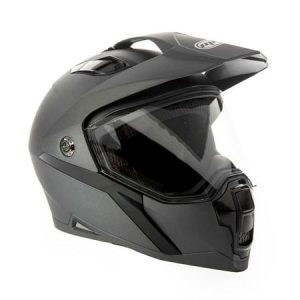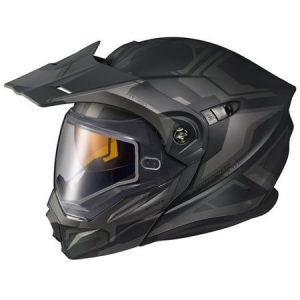Your motorcycle helmet is your shield against the elements and a crucial piece of safety gear. It’s vital to ensure your helmet offers optimal protection, and that means understanding its lifespan. This article dives deep into how long a motorcycle helmet lasts, the factors affecting its longevity, and the telltale signs it’s time for a replacement.
Understanding the 5-Year Rule (and Why It Matters)
Most helmet manufacturers recommend replacing your helmet every five years. This recommendation isn’t arbitrary. The key component responsible for impact absorption is the Expanded Polystyrene (EPS) liner. Over time, the EPS liner breaks down and loses its effectiveness in absorbing impact energy during a crash.

Think of the EPS liner like a sponge. A new EPS liner is like a fresh, dense sponge, effectively absorbing a blow. However, with age and exposure to heat, sunlight, and sweat, the EPS liner degrades, becoming brittle and less absorbent. This compromises its ability to protect your head in a crash.
Factors That Affect Your Helmet’s Lifespan
While five years is a good general guideline, several factors can influence your helmet’s lifespan:
- Frequency of Use: Regularly used helmets will naturally degrade faster than those used infrequently. Daily commutes expose your helmet to more wear and tear compared to occasional weekend rides.
- Exposure to Elements: Excessive heat, sunlight, and harsh chemicals can accelerate EPS liner breakdown. Leaving your helmet in direct sunlight or storing it in extreme temperatures shortens its lifespan.
- Accidents and Drops: Even minor drops or bumps can damage the helmet’s integrity, compromising its protective capabilities. If your helmet has been in an accident, regardless of severity, it’s crucial to replace it.
- Cleaning and Maintenance: Regular cleaning with appropriate products extends your helmet’s lifespan. Sweat, dirt, and grime can break down the liner and padding, so proper maintenance is key.
Signs Your Helmet Needs Replacing
Beyond the five-year mark, there are specific signs that indicate your helmet needs replacing:

- Visible Damage: Cracks, deep scratches, or gouges in the shell compromise its structural integrity.
- Loose or Worn Padding: Worn-out padding reduces comfort and its ability to provide a snug fit, which is essential for optimal protection.
- Difficulty Fastening the Chin Strap: A damaged or worn-out chin strap hinders proper helmet fit, rendering it less effective in a crash.
- Sticky or Brittle EPS Liner: If the EPS liner feels sticky, crumbles when touched, or has hardened significantly, it’s time for a new helmet.
- Musty Odors: Persistent unpleasant smells indicate excessive sweat buildup and potential liner degradation.
Don’t Skimp on Safety: Invest in a New Helmet
A motorcycle helmet is an investment in your safety. While replacing a perfectly functional helmet might seem unnecessary, remember, it’s the one piece of equipment standing between you and serious injury in a crash. Here’s why prioritizing a new helmet is crucial:
- Enhanced Protection: A new helmet offers optimal impact absorption thanks to a fresh, effective EPS liner.
- Improved Comfort: A snug-fitting helmet with comfortable padding ensures a pleasant riding experience.
- Peace of Mind: Knowing your helmet is up-to-date and offers the best possible protection provides invaluable peace of mind on the road.
Choosing the Right Replacement Helmet
When selecting a new helmet, prioritize safety, comfort, and fit. Here are some key factors to consider:

- Helmet Safety Rating: Look for helmets that have earned high safety ratings from independent testing organizations like Snell Memorial Foundation and DOT.
- Helmet Type: Choose a helmet style that suits your riding style. Full-face helmets offer maximum protection, while modular helmets provide versatility.
- Comfort and Fit: A snug yet comfortable fit is essential. The helmet shouldn’t feel loose or cause pressure points.
- Ventilation: Opt for a helmet with a good ventilation system to keep you cool and comfortable on hot rides.
- Visor Options: Consider a helmet with a scratch-resistant, anti-fog visor for optimal visibility.
Taking Care of Your New Helmet
Once you’ve invested in a new helmet, proper care extends its lifespan:
- Store It Properly: Store your helmet in a cool, dry place away from direct sunlight and extreme temperatures.
- Clean It Regularly: Use a mild soap and water solution to clean the helmet’s exterior. For the interior, use a helmet cleaning spray designed for the specific liner material.
- Avoid Harsh Chemicals: Avoid using harsh chemicals or abrasive cleaners, as they can damage the helmet’s shell and liner.
- Inspect It Regularly: Regularly check for any signs of damage, wear, or loose components.
Invest in Your Safety: Ride with Confidence with a New Helmet
Replacing your motorcycle helmet might not be at the top of your excitement list, but it’s undeniably one of the most crucial decisions you make as a rider. Here’s how a new helmet can elevate your riding experience:

- Confidence on the Road: Knowing you’re equipped with the best possible protection fosters a sense of confidence and allows you to focus on enjoying the ride.
- Reduced Anxiety: The worry of a compromised helmet fades away, replaced by the peace of mind that comes with a new, reliable safety shield.
- Enhanced Focus: Without nagging concerns about your helmet’s effectiveness, you can concentrate fully on the road and the exhilarating experience of riding.
Beyond Safety: The Additional Benefits of a New Helmet
A new helmet offers more than just top-notch protection. Here are some additional advantages:

- Improved Comfort: Modern helmets boast advanced ventilation systems and plush padding, ensuring a comfortable ride even on long journeys.
- Technological Advancements: New helmets often integrate features like Bluetooth communication systems, sun visors, and improved peripheral vision, enhancing your riding experience.
- Stylish Options: Gone are the days of bulky, uncomfortable helmets. Today’s helmets come in a variety of styles and colors, allowing you to express your personality while staying safe.
Don’t Wait Until It’s Too Late: Replace Your Helmet Today
While some riders might push the boundaries of the five-year guideline, it’s never worth risking your safety. If your helmet exhibits any signs of wear or damage, or if it’s nearing the five-year mark, prioritize replacing it. Remember, a new helmet is an investment, not an expense. It’s an investment in your safety, your peace of mind, and your overall riding experience.





